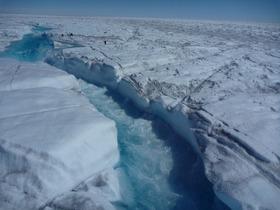
Greenland’s supraglacial rivers are large and swift.
As the largest single chunk of melting snow and ice in the world, the massive ice sheet that covers about 80 percent of Greenland is recognized as the biggest potential contributor to rising sea levels due to glacial meltwater.
Until now, however, scientists’ attention has mostly focused on the ice sheet’s aquamarine lakes — bodies of meltwater that tend to abruptly drain — and on monster chunks of ice that slide into the ocean to become icebergs.
But a new study involving City College of New York scientistMarco Tedesco and a UCLA team reveals a vast network of little-understood rivers and streams flowing on top of the ice sheet that could be responsible for at least as much, if not more, sea-level rise as the other two sources combined.
“It’s the world’s biggest water park, with magnificent and beautiful — but deadly — rushing blue rivers cutting canyons into the ice,” said Laurence C. Smith, the study’s lead author and the chair of UCLA’s geography department.
The group also specifically examined the Isortoq River, which exits the ice sheet on land and drains about one-fifth of the mapped networks. Its output is critical because it’s a key element of the Modele Atmospherique Regional, or MAR, a climate model used by the Intergovernmental Panel on Climate Change to develop worldwide responses to global warming. The researchers found that the Isortoq’s amount of discharge was more than 25 percent less than the model predicted.
“The model automatically assumes that the meltwater is going directly to the ocean,” said Professor Tedesco, a co-author and head of City College’s Cryospheric Processes Laboratory, which operates MAR. “Some can get retained under the ice. More research is definitely needed.”
“If we can get better estimates, then we can have better projections for the extent and the impact of global warming,” said Professor Tedesco. “Greenland is really the big player for sea level rise in the future, so improving climate models is extremely crucial.”
The research appears in the latest issue of Proceedings of the National Academy of Sciences. The study was funded by NASA’s Cryospheric Sciences program.
About The City College of New York
Since 1847, The City College of New York has provided low-cost, high-quality education for New Yorkers in a wide variety of disciplines. More than 16,000 students pursue undergraduate and graduate degrees in: the College of Liberal Arts and Sciences; the Bernard and Anne Spitzer School of Architecture; the School of Education; the Grove School of Engineering; the Sophie Davis School of Biomedical Education, and the Colin Powell School for Civic and Global Leadership. U.S. News, Princeton Review and Forbes all rank City College among the best colleges and universities in the United States.